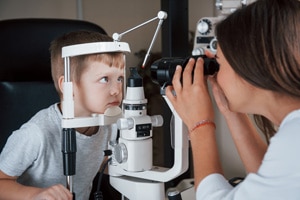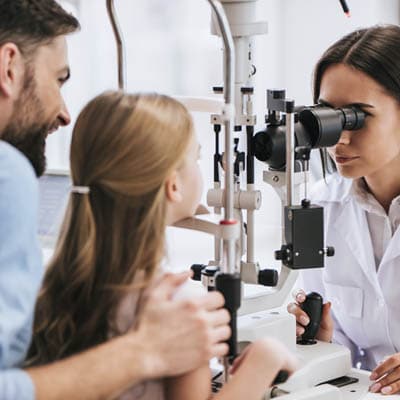It may be Time to Request a Professional Comprehensive Eye Exam
School-aged children, usually between the ages of five and nine, begin a yearly regiment of vision testing. If all looks well according to the optometrist or professional practitioner heading the testing sessions, you and your child have haphazardly leapt over that most dreaded canyon that determines whether or not glasses are in your child’s immediate future. Then there are an, arguably, unfortunate group of children who find themselves hearing the words, or better yet, professional jargon, that includes “near-sighted,” “far-sighted,” or “astigmatism.” You and your child will then, sometimes reluctantly, find yourselves in the local optometrist’s office for a standard second opinion.
After an initial verification of the school examiner’s findings, you and your child will have already picked out the perfect frame style and color to match their personality the most. Others may have passed the yearly vision exam held at the same school, at the same time, but they may still be having problems with their vision, unbeknown to their parents, or even to themselves. If, perchance, parent or child happens to notice something “odd” with their eyes and/or vision while having passed the visual acuity test with a standard 20/20 measurement, it may be time to request a professional comprehensive eye exam offered by their local optometrist.
Comprehensive Eye Exam vs. Visual Acuity Test
The basic difference that sets the visual acuity test apart from that of a comprehensive eye exam is simply that the visual acuity test only measures a patient’s distance of vision; hence, visual acuity. If a patient’s visual acuity is labeled as 20/20, it never means that the patient has perfect vision. Having 20/20 vision only tells the patient being examined that they can see clearly and sharply at a standard testing distance of 20 feet while looking at a traditional, letter-riddled eye chart.
If the patient’s determined vision measurement is not so ideal, having vision acuity of 20/125, this means that the patient must be at least 20 feet away from the object in order to see, while a person with normal vision can see it just fine at only 20 feet. This test determines whether a person has 20/20 vision; can see near and not far, otherwise called near-sightedness; can see far and not near, also known as far-sightedness; or has an astigmatism of one or both eyes. The word astigmatism means that the patient’s cornea is shaped differently than normal, or it can also mean that the eye’s natural lens is formed in a curved fashion.

A comprehensive eye exam is much more specific to what your child’s vision problem or problems may be, concentrating on the testing of your child’s peripheral, or side vision, coordination of the eye, depth perception, object focus, and ability to see various colors. As you can see, there could be a number of potential vision issues that would not be found if a comprehensive eye exam were to be deemed unnecessary by you or your doctor. If a problem is discovered, vision therapy is an optional treatment, as opposed to or in addition to required surgery. Of course, at this point, glasses are out of the question.
Vision Therapy for the Still Struggling School-Aged Child
Vision therapy is not offered by every optometrist as a standard option for treatment of a child’s newly discovered visual problems. Once a practitioner in your area is located, you will soon see the amazing benefits that can be implemented through a professional’s strict regimen for lasting vision improvement. This is done by simply partaking of in-office vision therapy, coupled with at-home, self-therapy. Like physical therapy, vision therapy serves to help the child’s visual system correct itself naturally, through exercises that are specifically created to, essentially, erase the problem altogether, or to improve your child’s vision skills.
The treatment of professionally monitored vision therapy is becoming more popular every year for the most obvious reason: results. Vision therapy is widely acknowledged to help treat and even reverse amblyopia or “lazy eye,” as it is most popularly referred to as; strabismus in the form of misalignment of the eyes while reading; and phorias, a less obtrusive eye alignment issue that usually only causes eye strain and/or fatigue while reading.
Every benefit of your child’s vision therapy will ultimately lead to the improved and optimized performance of his or her vision system, similar to that of physical therapy for the musculoskeletal system, widely prescribed for patient’s suffering from bodily injury, physical birth defects, or age related performance problems. As vision therapy regimens are continuously researched and developed, fewer children will have to needlessly suffer from the debilitating effects of their deeper vision problems.
CONTACT US
Vision Care & Therapy Center

Dr. Janna Iyer, FCOVD
Dr. Alayna Larsen
11735 Pointe Place
Roswell, Ga 30076
678-256-3990
Office Hours
Mon-Thu 9:00am-6:00pm
Fri 9:00am-1:00pm
Appointments
678-256-3990
Patient Infomation


